Analysis of Kildare Road Congestion: Clearway Project Part B Report
VerifiedAdded on 2020/03/16
|12
|2565
|39
Report
AI Summary
This report, Part B of the Clearway Project, analyzes traffic congestion on Kildare Road. It begins with an introduction to the problem and outlines the objectives, which include identifying and quantifying the economic impacts of congestion. The methodology involves analyzing travel time delays, vehicle operating costs, and externality costs. The report explores economic analysis techniques like the dead-weight loss approach. It also discusses car parking mobility solutions, examining the conflicts between parking and mobility, and the costs associated with parking. The report presents suggestions for mitigating congestion and provides references. The analysis covers various aspects of congestion costs, including travel time, externalities, and vehicle operation, and proposes strategies for improvement. The report also examines the costs of parking and suggests various solutions to improve traffic flow.

Clearway Project
PART B
Kildare Road
PART B
Kildare Road
Paraphrase This Document
Need a fresh take? Get an instant paraphrase of this document with our AI Paraphraser
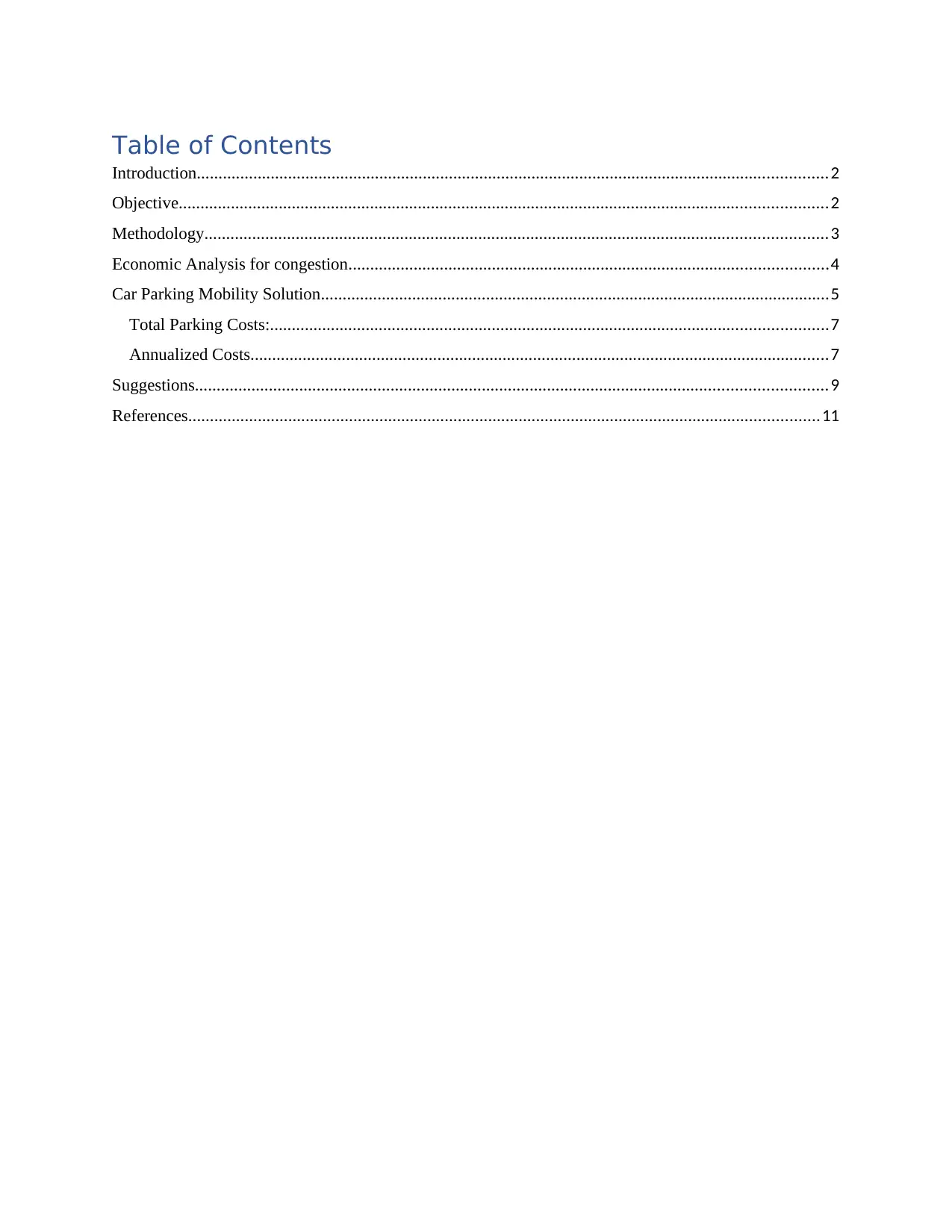
Table of Contents
Introduction.................................................................................................................................................2
Objective.....................................................................................................................................................2
Methodology...............................................................................................................................................3
Economic Analysis for congestion..............................................................................................................4
Car Parking Mobility Solution.....................................................................................................................5
Total Parking Costs:................................................................................................................................7
Annualized Costs.....................................................................................................................................7
Suggestions.................................................................................................................................................9
References.................................................................................................................................................11
Introduction.................................................................................................................................................2
Objective.....................................................................................................................................................2
Methodology...............................................................................................................................................3
Economic Analysis for congestion..............................................................................................................4
Car Parking Mobility Solution.....................................................................................................................5
Total Parking Costs:................................................................................................................................7
Annualized Costs.....................................................................................................................................7
Suggestions.................................................................................................................................................9
References.................................................................................................................................................11
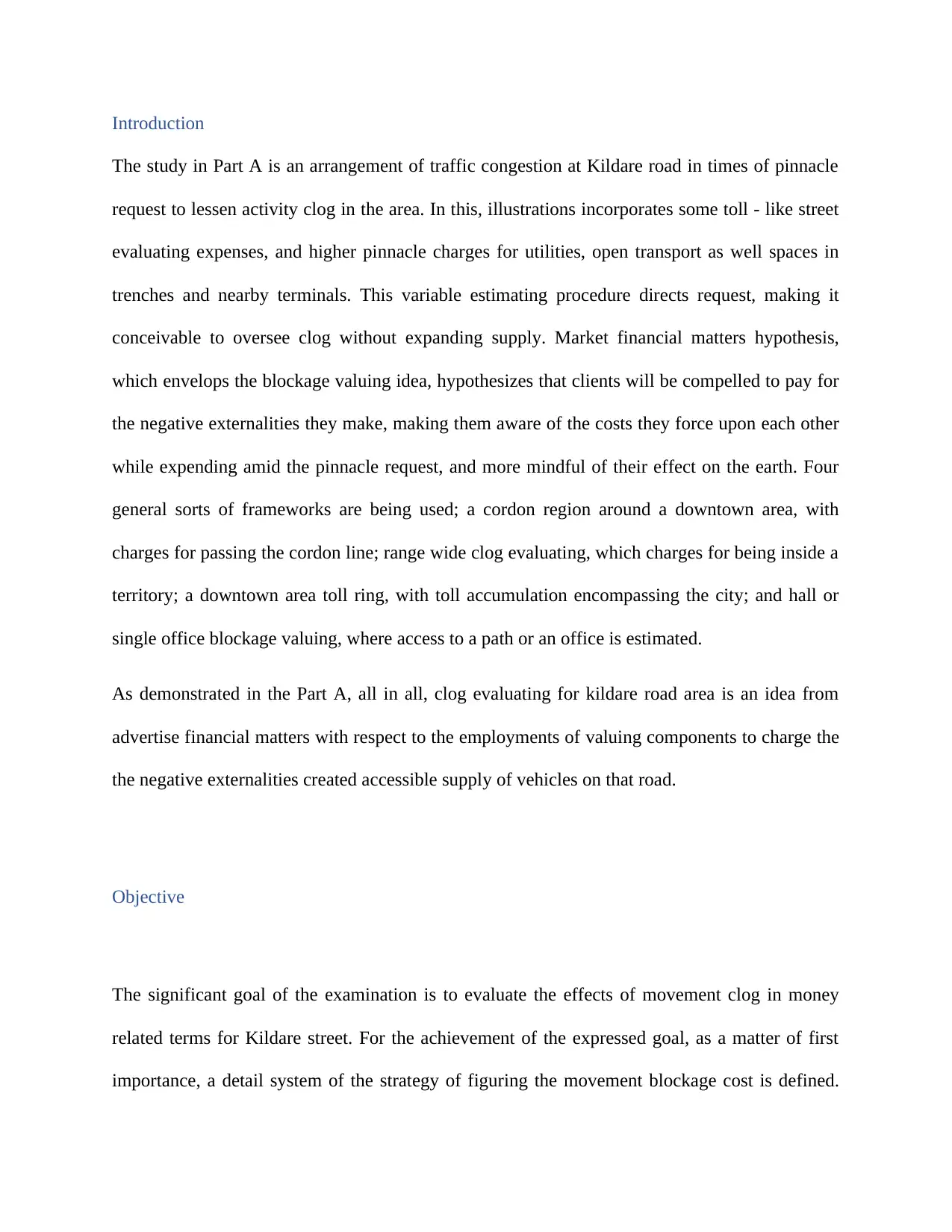
Introduction
The study in Part A is an arrangement of traffic congestion at Kildare road in times of pinnacle
request to lessen activity clog in the area. In this, illustrations incorporates some toll - like street
evaluating expenses, and higher pinnacle charges for utilities, open transport as well spaces in
trenches and nearby terminals. This variable estimating procedure directs request, making it
conceivable to oversee clog without expanding supply. Market financial matters hypothesis,
which envelops the blockage valuing idea, hypothesizes that clients will be compelled to pay for
the negative externalities they make, making them aware of the costs they force upon each other
while expending amid the pinnacle request, and more mindful of their effect on the earth. Four
general sorts of frameworks are being used; a cordon region around a downtown area, with
charges for passing the cordon line; range wide clog evaluating, which charges for being inside a
territory; a downtown area toll ring, with toll accumulation encompassing the city; and hall or
single office blockage valuing, where access to a path or an office is estimated.
As demonstrated in the Part A, all in all, clog evaluating for kildare road area is an idea from
advertise financial matters with respect to the employments of valuing components to charge the
the negative externalities created accessible supply of vehicles on that road.
Objective
The significant goal of the examination is to evaluate the effects of movement clog in money
related terms for Kildare street. For the achievement of the expressed goal, as a matter of first
importance, a detail system of the strategy of figuring the movement blockage cost is defined.
The study in Part A is an arrangement of traffic congestion at Kildare road in times of pinnacle
request to lessen activity clog in the area. In this, illustrations incorporates some toll - like street
evaluating expenses, and higher pinnacle charges for utilities, open transport as well spaces in
trenches and nearby terminals. This variable estimating procedure directs request, making it
conceivable to oversee clog without expanding supply. Market financial matters hypothesis,
which envelops the blockage valuing idea, hypothesizes that clients will be compelled to pay for
the negative externalities they make, making them aware of the costs they force upon each other
while expending amid the pinnacle request, and more mindful of their effect on the earth. Four
general sorts of frameworks are being used; a cordon region around a downtown area, with
charges for passing the cordon line; range wide clog evaluating, which charges for being inside a
territory; a downtown area toll ring, with toll accumulation encompassing the city; and hall or
single office blockage valuing, where access to a path or an office is estimated.
As demonstrated in the Part A, all in all, clog evaluating for kildare road area is an idea from
advertise financial matters with respect to the employments of valuing components to charge the
the negative externalities created accessible supply of vehicles on that road.
Objective
The significant goal of the examination is to evaluate the effects of movement clog in money
related terms for Kildare street. For the achievement of the expressed goal, as a matter of first
importance, a detail system of the strategy of figuring the movement blockage cost is defined.
⊘ This is a preview!⊘
Do you want full access?
Subscribe today to unlock all pages.

Trusted by 1+ million students worldwide
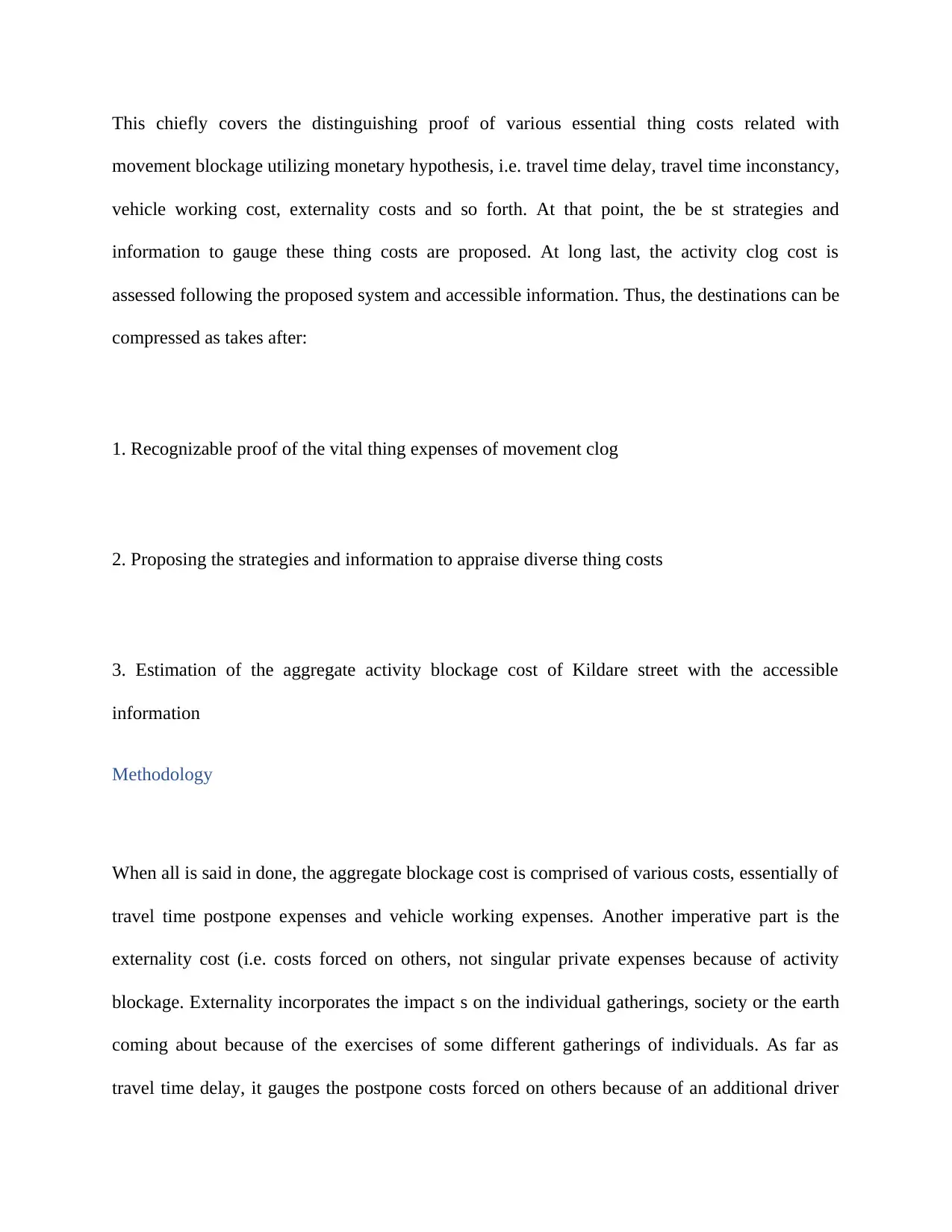
This chiefly covers the distinguishing proof of various essential thing costs related with
movement blockage utilizing monetary hypothesis, i.e. travel time delay, travel time inconstancy,
vehicle working cost, externality costs and so forth. At that point, the be st strategies and
information to gauge these thing costs are proposed. At long last, the activity clog cost is
assessed following the proposed system and accessible information. Thus, the destinations can be
compressed as takes after:
1. Recognizable proof of the vital thing expenses of movement clog
2. Proposing the strategies and information to appraise diverse thing costs
3. Estimation of the aggregate activity blockage cost of Kildare street with the accessible
information
Methodology
When all is said in done, the aggregate blockage cost is comprised of various costs, essentially of
travel time postpone expenses and vehicle working expenses. Another imperative part is the
externality cost (i.e. costs forced on others, not singular private expenses because of activity
blockage. Externality incorporates the impact s on the individual gatherings, society or the earth
coming about because of the exercises of some different gatherings of individuals. As far as
travel time delay, it gauges the postpone costs forced on others because of an additional driver
movement blockage utilizing monetary hypothesis, i.e. travel time delay, travel time inconstancy,
vehicle working cost, externality costs and so forth. At that point, the be st strategies and
information to gauge these thing costs are proposed. At long last, the activity clog cost is
assessed following the proposed system and accessible information. Thus, the destinations can be
compressed as takes after:
1. Recognizable proof of the vital thing expenses of movement clog
2. Proposing the strategies and information to appraise diverse thing costs
3. Estimation of the aggregate activity blockage cost of Kildare street with the accessible
information
Methodology
When all is said in done, the aggregate blockage cost is comprised of various costs, essentially of
travel time postpone expenses and vehicle working expenses. Another imperative part is the
externality cost (i.e. costs forced on others, not singular private expenses because of activity
blockage. Externality incorporates the impact s on the individual gatherings, society or the earth
coming about because of the exercises of some different gatherings of individuals. As far as
travel time delay, it gauges the postpone costs forced on others because of an additional driver
Paraphrase This Document
Need a fresh take? Get an instant paraphrase of this document with our AI Paraphraser
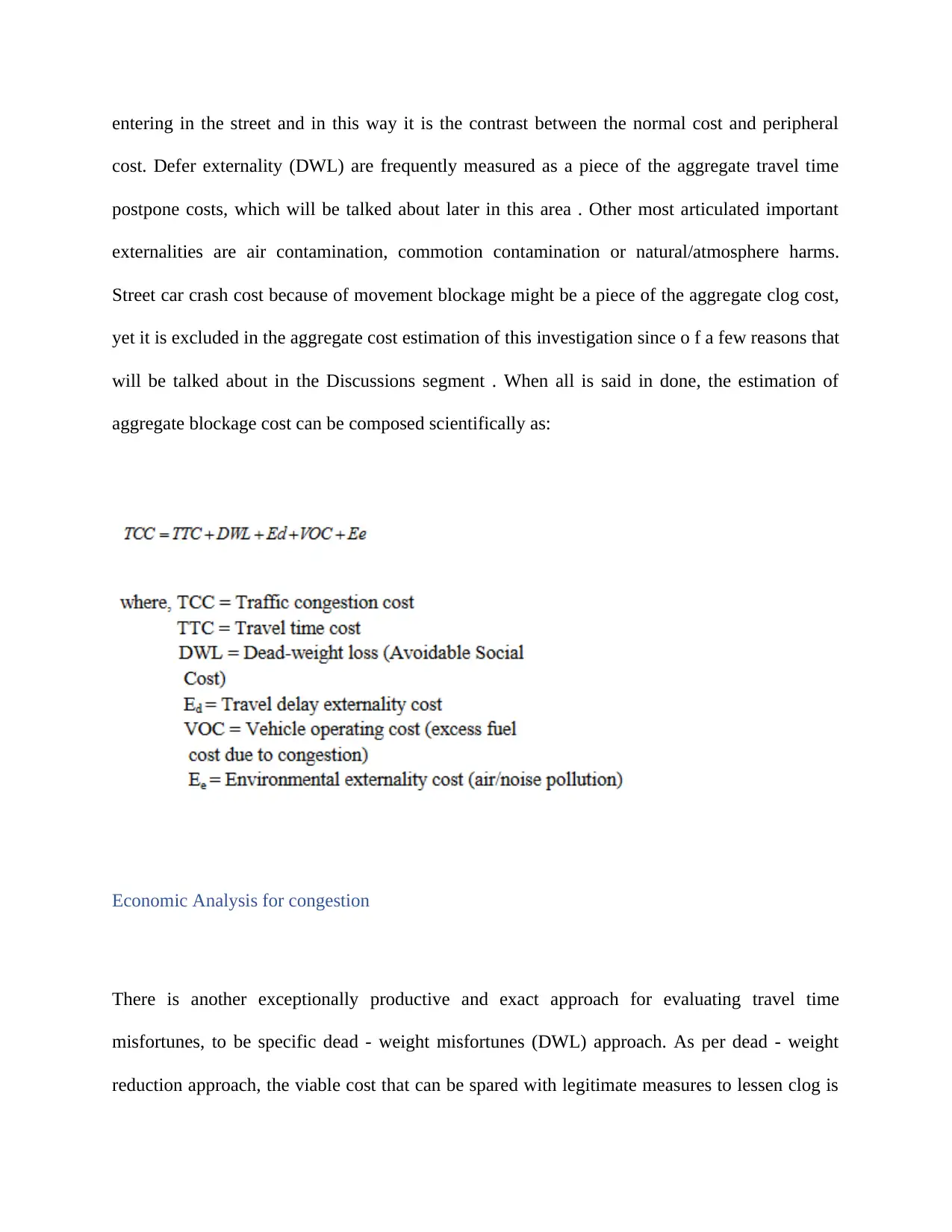
entering in the street and in this way it is the contrast between the normal cost and peripheral
cost. Defer externality (DWL) are frequently measured as a piece of the aggregate travel time
postpone costs, which will be talked about later in this area . Other most articulated important
externalities are air contamination, commotion contamination or natural/atmosphere harms.
Street car crash cost because of movement blockage might be a piece of the aggregate clog cost,
yet it is excluded in the aggregate cost estimation of this investigation since o f a few reasons that
will be talked about in the Discussions segment . When all is said in done, the estimation of
aggregate blockage cost can be composed scientifically as:
Economic Analysis for congestion
There is another exceptionally productive and exact approach for evaluating travel time
misfortunes, to be specific dead - weight misfortunes (DWL) approach. As per dead - weight
reduction approach, the viable cost that can be spared with legitimate measures to lessen clog is
cost. Defer externality (DWL) are frequently measured as a piece of the aggregate travel time
postpone costs, which will be talked about later in this area . Other most articulated important
externalities are air contamination, commotion contamination or natural/atmosphere harms.
Street car crash cost because of movement blockage might be a piece of the aggregate clog cost,
yet it is excluded in the aggregate cost estimation of this investigation since o f a few reasons that
will be talked about in the Discussions segment . When all is said in done, the estimation of
aggregate blockage cost can be composed scientifically as:
Economic Analysis for congestion
There is another exceptionally productive and exact approach for evaluating travel time
misfortunes, to be specific dead - weight misfortunes (DWL) approach. As per dead - weight
reduction approach, the viable cost that can be spared with legitimate measures to lessen clog is
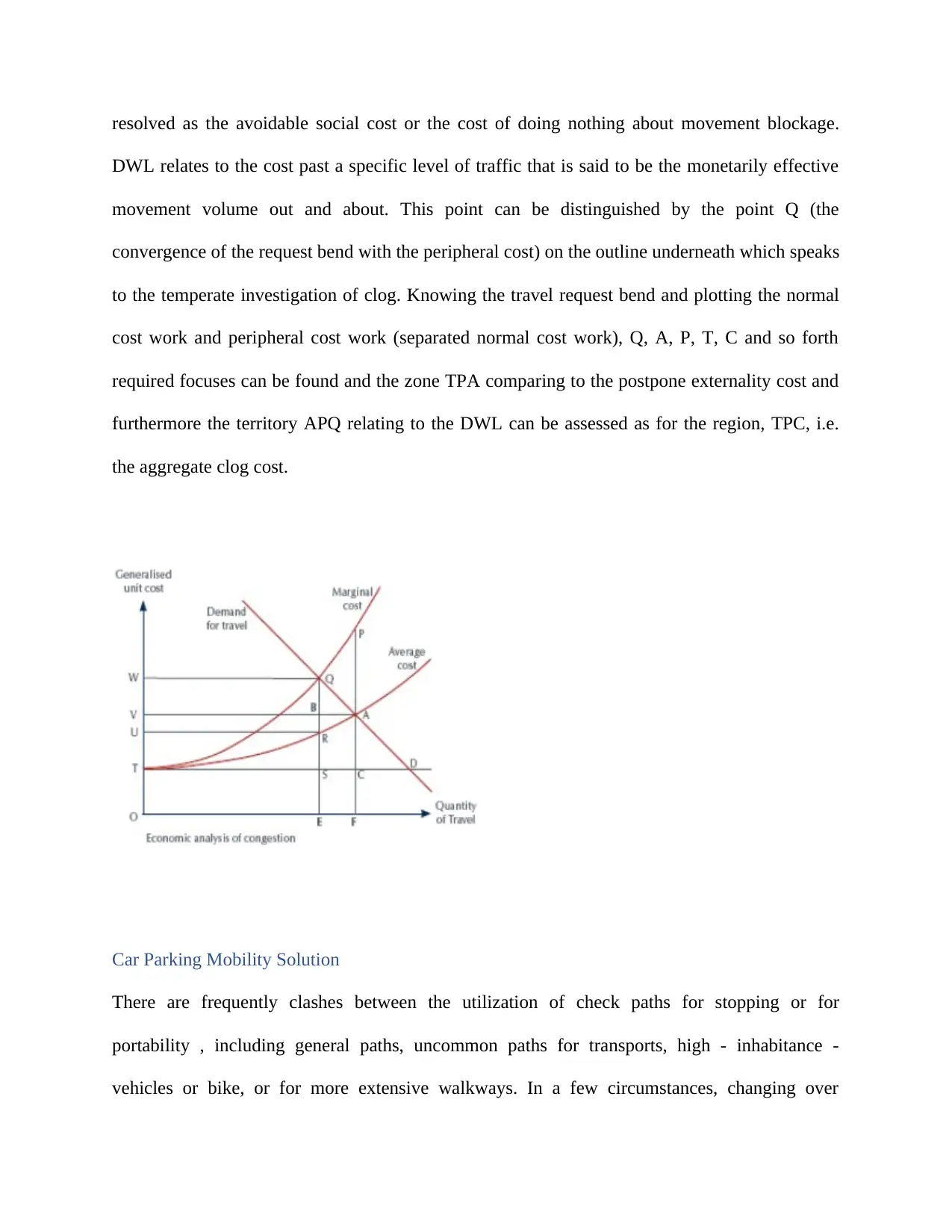
resolved as the avoidable social cost or the cost of doing nothing about movement blockage.
DWL relates to the cost past a specific level of traffic that is said to be the monetarily effective
movement volume out and about. This point can be distinguished by the point Q (the
convergence of the request bend with the peripheral cost) on the outline underneath which speaks
to the temperate investigation of clog. Knowing the travel request bend and plotting the normal
cost work and peripheral cost work (separated normal cost work), Q, A, P, T, C and so forth
required focuses can be found and the zone TPA comparing to the postpone externality cost and
furthermore the territory APQ relating to the DWL can be assessed as for the region, TPC, i.e.
the aggregate clog cost.
Car Parking Mobility Solution
There are frequently clashes between the utilization of check paths for stopping or for
portability , including general paths, uncommon paths for transports, high - inhabitance -
vehicles or bike, or for more extensive walkways. In a few circumstances, changing over
DWL relates to the cost past a specific level of traffic that is said to be the monetarily effective
movement volume out and about. This point can be distinguished by the point Q (the
convergence of the request bend with the peripheral cost) on the outline underneath which speaks
to the temperate investigation of clog. Knowing the travel request bend and plotting the normal
cost work and peripheral cost work (separated normal cost work), Q, A, P, T, C and so forth
required focuses can be found and the zone TPA comparing to the postpone externality cost and
furthermore the territory APQ relating to the DWL can be assessed as for the region, TPC, i.e.
the aggregate clog cost.
Car Parking Mobility Solution
There are frequently clashes between the utilization of check paths for stopping or for
portability , including general paths, uncommon paths for transports, high - inhabitance -
vehicles or bike, or for more extensive walkways. In a few circumstances, changing over
⊘ This is a preview!⊘
Do you want full access?
Subscribe today to unlock all pages.

Trusted by 1+ million students worldwide
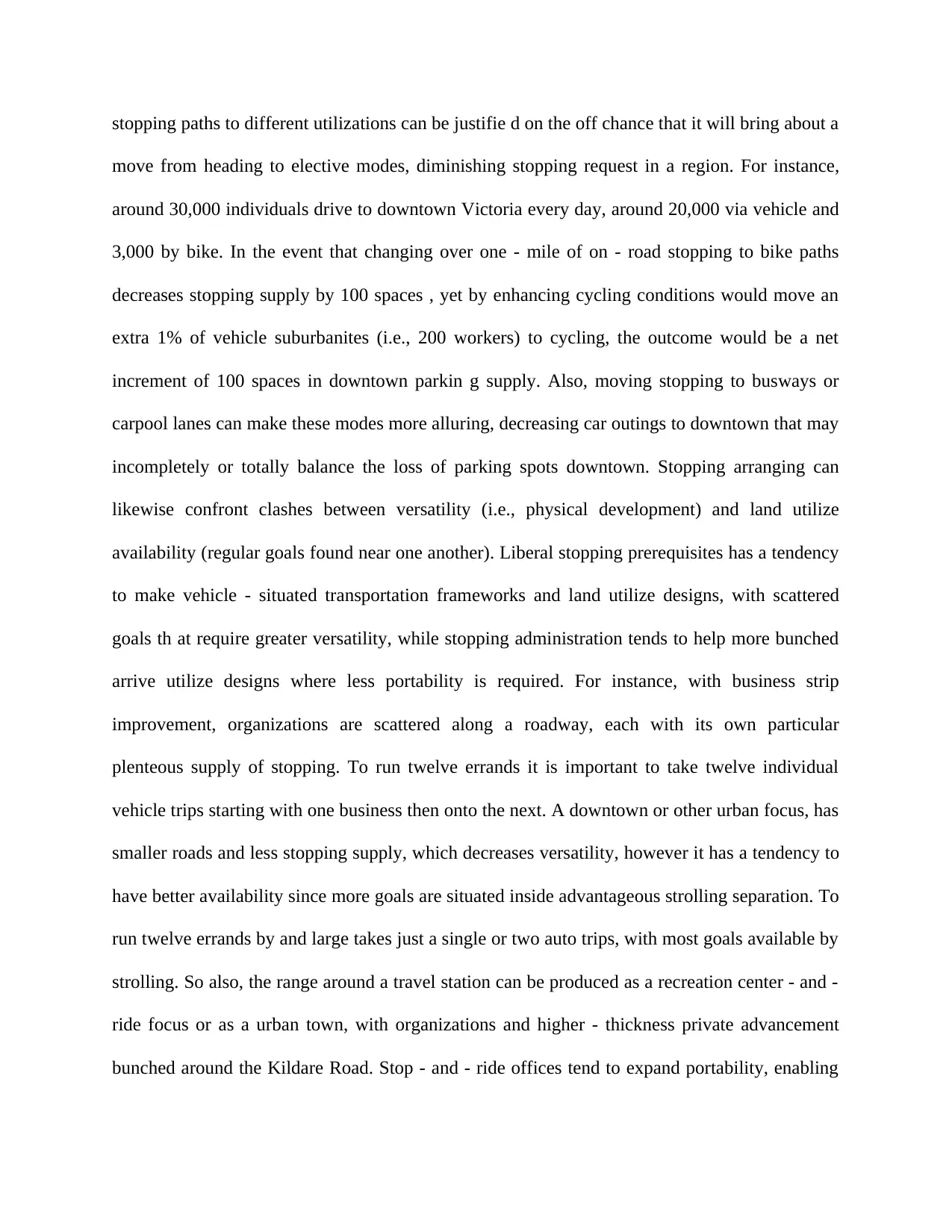
stopping paths to different utilizations can be justifie d on the off chance that it will bring about a
move from heading to elective modes, diminishing stopping request in a region. For instance,
around 30,000 individuals drive to downtown Victoria every day, around 20,000 via vehicle and
3,000 by bike. In the event that changing over one - mile of on - road stopping to bike paths
decreases stopping supply by 100 spaces , yet by enhancing cycling conditions would move an
extra 1% of vehicle suburbanites (i.e., 200 workers) to cycling, the outcome would be a net
increment of 100 spaces in downtown parkin g supply. Also, moving stopping to busways or
carpool lanes can make these modes more alluring, decreasing car outings to downtown that may
incompletely or totally balance the loss of parking spots downtown. Stopping arranging can
likewise confront clashes between versatility (i.e., physical development) and land utilize
availability (regular goals found near one another). Liberal stopping prerequisites has a tendency
to make vehicle - situated transportation frameworks and land utilize designs, with scattered
goals th at require greater versatility, while stopping administration tends to help more bunched
arrive utilize designs where less portability is required. For instance, with business strip
improvement, organizations are scattered along a roadway, each with its own particular
plenteous supply of stopping. To run twelve errands it is important to take twelve individual
vehicle trips starting with one business then onto the next. A downtown or other urban focus, has
smaller roads and less stopping supply, which decreases versatility, however it has a tendency to
have better availability since more goals are situated inside advantageous strolling separation. To
run twelve errands by and large takes just a single or two auto trips, with most goals available by
strolling. So also, the range around a travel station can be produced as a recreation center - and -
ride focus or as a urban town, with organizations and higher - thickness private advancement
bunched around the Kildare Road. Stop - and - ride offices tend to expand portability, enabling
move from heading to elective modes, diminishing stopping request in a region. For instance,
around 30,000 individuals drive to downtown Victoria every day, around 20,000 via vehicle and
3,000 by bike. In the event that changing over one - mile of on - road stopping to bike paths
decreases stopping supply by 100 spaces , yet by enhancing cycling conditions would move an
extra 1% of vehicle suburbanites (i.e., 200 workers) to cycling, the outcome would be a net
increment of 100 spaces in downtown parkin g supply. Also, moving stopping to busways or
carpool lanes can make these modes more alluring, decreasing car outings to downtown that may
incompletely or totally balance the loss of parking spots downtown. Stopping arranging can
likewise confront clashes between versatility (i.e., physical development) and land utilize
availability (regular goals found near one another). Liberal stopping prerequisites has a tendency
to make vehicle - situated transportation frameworks and land utilize designs, with scattered
goals th at require greater versatility, while stopping administration tends to help more bunched
arrive utilize designs where less portability is required. For instance, with business strip
improvement, organizations are scattered along a roadway, each with its own particular
plenteous supply of stopping. To run twelve errands it is important to take twelve individual
vehicle trips starting with one business then onto the next. A downtown or other urban focus, has
smaller roads and less stopping supply, which decreases versatility, however it has a tendency to
have better availability since more goals are situated inside advantageous strolling separation. To
run twelve errands by and large takes just a single or two auto trips, with most goals available by
strolling. So also, the range around a travel station can be produced as a recreation center - and -
ride focus or as a urban town, with organizations and higher - thickness private advancement
bunched around the Kildare Road. Stop - and - ride offices tend to expand portability, enabling
Paraphrase This Document
Need a fresh take? Get an instant paraphrase of this document with our AI Paraphraser
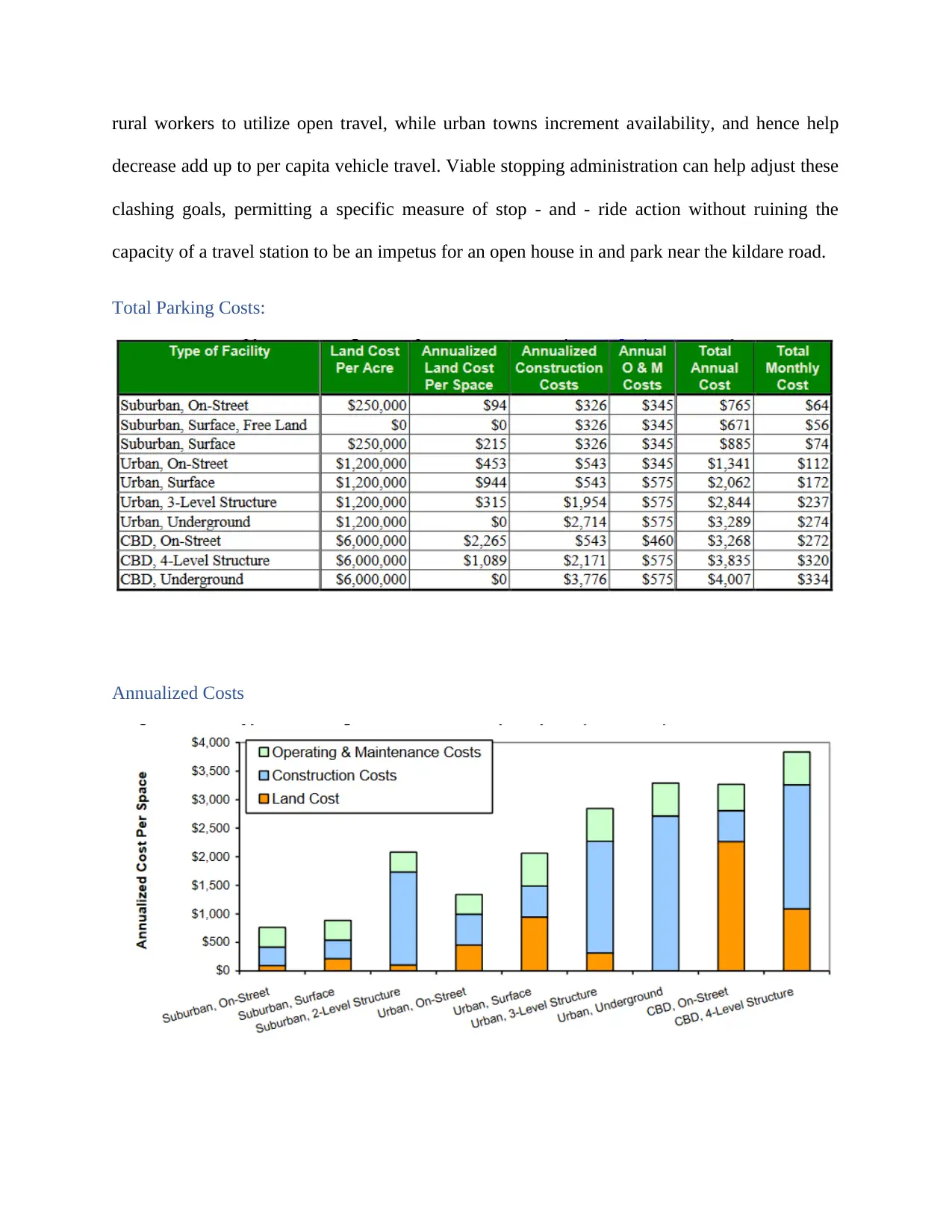
rural workers to utilize open travel, while urban towns increment availability, and hence help
decrease add up to per capita vehicle travel. Viable stopping administration can help adjust these
clashing goals, permitting a specific measure of stop - and - ride action without ruining the
capacity of a travel station to be an impetus for an open house in and park near the kildare road.
Total Parking Costs:
Annualized Costs
decrease add up to per capita vehicle travel. Viable stopping administration can help adjust these
clashing goals, permitting a specific measure of stop - and - ride action without ruining the
capacity of a travel station to be an impetus for an open house in and park near the kildare road.
Total Parking Costs:
Annualized Costs
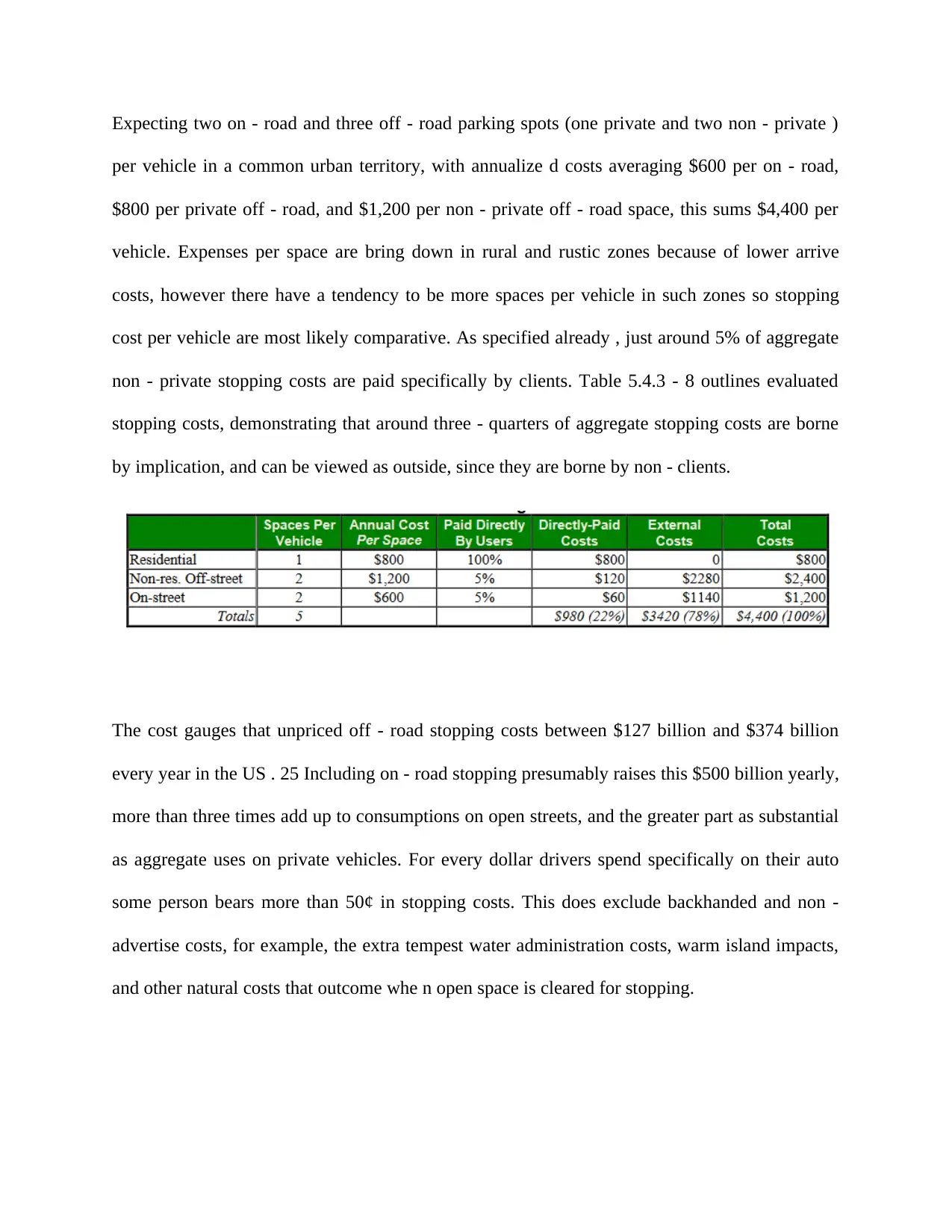
Expecting two on - road and three off - road parking spots (one private and two non - private )
per vehicle in a common urban territory, with annualize d costs averaging $600 per on - road,
$800 per private off - road, and $1,200 per non - private off - road space, this sums $4,400 per
vehicle. Expenses per space are bring down in rural and rustic zones because of lower arrive
costs, however there have a tendency to be more spaces per vehicle in such zones so stopping
cost per vehicle are most likely comparative. As specified already , just around 5% of aggregate
non - private stopping costs are paid specifically by clients. Table 5.4.3 - 8 outlines evaluated
stopping costs, demonstrating that around three - quarters of aggregate stopping costs are borne
by implication, and can be viewed as outside, since they are borne by non - clients.
The cost gauges that unpriced off - road stopping costs between $127 billion and $374 billion
every year in the US . 25 Including on - road stopping presumably raises this $500 billion yearly,
more than three times add up to consumptions on open streets, and the greater part as substantial
as aggregate uses on private vehicles. For every dollar drivers spend specifically on their auto
some person bears more than 50¢ in stopping costs. This does exclude backhanded and non -
advertise costs, for example, the extra tempest water administration costs, warm island impacts,
and other natural costs that outcome whe n open space is cleared for stopping.
per vehicle in a common urban territory, with annualize d costs averaging $600 per on - road,
$800 per private off - road, and $1,200 per non - private off - road space, this sums $4,400 per
vehicle. Expenses per space are bring down in rural and rustic zones because of lower arrive
costs, however there have a tendency to be more spaces per vehicle in such zones so stopping
cost per vehicle are most likely comparative. As specified already , just around 5% of aggregate
non - private stopping costs are paid specifically by clients. Table 5.4.3 - 8 outlines evaluated
stopping costs, demonstrating that around three - quarters of aggregate stopping costs are borne
by implication, and can be viewed as outside, since they are borne by non - clients.
The cost gauges that unpriced off - road stopping costs between $127 billion and $374 billion
every year in the US . 25 Including on - road stopping presumably raises this $500 billion yearly,
more than three times add up to consumptions on open streets, and the greater part as substantial
as aggregate uses on private vehicles. For every dollar drivers spend specifically on their auto
some person bears more than 50¢ in stopping costs. This does exclude backhanded and non -
advertise costs, for example, the extra tempest water administration costs, warm island impacts,
and other natural costs that outcome whe n open space is cleared for stopping.
⊘ This is a preview!⊘
Do you want full access?
Subscribe today to unlock all pages.

Trusted by 1+ million students worldwide

Suggestions
The most recent accessible information, following the detail estimation strategy, decides the
assessments of aggregate movement blockage cost and its individual thing costs in Dhaka city .
This paper characterizes the clog cost as made out of mostly three part costs, in particular, travel
time costs, vehicle working expenses and externality cost because of postponement and
ecological harms. It is vital to specify her e that various related examinations frequently allude to
two extra related expenses and in like manner require the assessments on cargo activity cost as a
critical business cost and street auto collision cost emerging from movement blockage. The
abundance cost o f cargo movement is chiefly because of the normal holding up time that the
cargo needs to look for activity blockage amid top hours. For Dhaka city, this isn't a prime
wellspring of clog cost on the grounds that the cargo activity is just permitted to enter the city d
uring off - crest hours during the evening keeping in mind the end goal to stay away from the
blockage. Consequently this is significantly identified with arrangement - making of government
and not identified with clog especially for Dhaka city presently. Then again, with respect to the
street auto collision cost, it is exceptionally hard to discover the correct number of mischances
that occur because of clog. Here the casualty of mischances relies upon the speed of the vehicle
which is primarily due to the enticed drivers tending to drive quicker keeping in mind the end
goal to evade the speed misfortune, yet for this situation, the level of lives spared or less casualty
due to slower speed amid blockage ought to likewise be considered. For these dubious issues,
these two things are excluded in this investigation however many examinations allude to these
two expenses as customary segments of aggregate clog cost. The breakdown of the aggregate
expenses of activity blockage is outlined in Table IV . Examining the qualities in Table IV , it is
The most recent accessible information, following the detail estimation strategy, decides the
assessments of aggregate movement blockage cost and its individual thing costs in Dhaka city .
This paper characterizes the clog cost as made out of mostly three part costs, in particular, travel
time costs, vehicle working expenses and externality cost because of postponement and
ecological harms. It is vital to specify her e that various related examinations frequently allude to
two extra related expenses and in like manner require the assessments on cargo activity cost as a
critical business cost and street auto collision cost emerging from movement blockage. The
abundance cost o f cargo movement is chiefly because of the normal holding up time that the
cargo needs to look for activity blockage amid top hours. For Dhaka city, this isn't a prime
wellspring of clog cost on the grounds that the cargo activity is just permitted to enter the city d
uring off - crest hours during the evening keeping in mind the end goal to stay away from the
blockage. Consequently this is significantly identified with arrangement - making of government
and not identified with clog especially for Dhaka city presently. Then again, with respect to the
street auto collision cost, it is exceptionally hard to discover the correct number of mischances
that occur because of clog. Here the casualty of mischances relies upon the speed of the vehicle
which is primarily due to the enticed drivers tending to drive quicker keeping in mind the end
goal to evade the speed misfortune, yet for this situation, the level of lives spared or less casualty
due to slower speed amid blockage ought to likewise be considered. For these dubious issues,
these two things are excluded in this investigation however many examinations allude to these
two expenses as customary segments of aggregate clog cost. The breakdown of the aggregate
expenses of activity blockage is outlined in Table IV . Examining the qualities in Table IV , it is
Paraphrase This Document
Need a fresh take? Get an instant paraphrase of this document with our AI Paraphraser

discovered that travel time cos t with fluctuation alone is 39 % of the whole cost while
externality cost s bears 37 % and vehicle working expense as far as overabundance fuel copied
and oil cost is around 5 % just . The dead - weight misfortunes speaking to the avoidable social
cost of blockage or cost of really doing nothing about clog is around 19 % of the whole cost.
Once more, among the externalities, postpone externalities have a more prominent offer, i.e. 27%
of the aggregate cost, than the ecological externalities (10% of the aggregate cost).
Computations of per - vehicle stopping expenses and incomes should consider stack factors , that
is, the segment of parking spots that are utilized at a specific time, or the part of hours or days
every year that a space is utilized. For instance, if parking spots lease for $60 every month with a
half normal load factor, incomes normal $30 per space. A diminishment in stopping request does
not generally give a practically identical cost reserve funds. For instance, if a business has
bounteous stopping supply there might be no quick stopping cost funds if workers move to
elective drive modes. Their stop ing spaces will essentially be vacant. Be that as it may, as time
goes on practically all stopping offices have an open door cost: diminished request lessens
stopping clog (for instance, stopping turn out to be more advantageous for clients), maintains a
strategic distance from the need to increment parkin g supply (for instance, if a business grows,
or another business is set up close-by), overabundance spaces can be leased to other adjacent
clients who require them, or the land can be changed over to another utilization (sold, utilized for
an extra building, or changed over to greenspace).
References
externality cost s bears 37 % and vehicle working expense as far as overabundance fuel copied
and oil cost is around 5 % just . The dead - weight misfortunes speaking to the avoidable social
cost of blockage or cost of really doing nothing about clog is around 19 % of the whole cost.
Once more, among the externalities, postpone externalities have a more prominent offer, i.e. 27%
of the aggregate cost, than the ecological externalities (10% of the aggregate cost).
Computations of per - vehicle stopping expenses and incomes should consider stack factors , that
is, the segment of parking spots that are utilized at a specific time, or the part of hours or days
every year that a space is utilized. For instance, if parking spots lease for $60 every month with a
half normal load factor, incomes normal $30 per space. A diminishment in stopping request does
not generally give a practically identical cost reserve funds. For instance, if a business has
bounteous stopping supply there might be no quick stopping cost funds if workers move to
elective drive modes. Their stop ing spaces will essentially be vacant. Be that as it may, as time
goes on practically all stopping offices have an open door cost: diminished request lessens
stopping clog (for instance, stopping turn out to be more advantageous for clients), maintains a
strategic distance from the need to increment parkin g supply (for instance, if a business grows,
or another business is set up close-by), overabundance spaces can be leased to other adjacent
clients who require them, or the land can be changed over to another utilization (sold, utilized for
an extra building, or changed over to greenspace).
References

Manufacturing skills Australia. (2017, September 6). Retrieved from
http://sustainabilityskills.net.au/what-is-sustainability/sustainability-practice/strategy-
and-management/community-impact
RMS. (2017, August 27). Retrieved from http://rmscivil.net.au/projects
Roads and Maritimes. (2017, September 8). Retrieved from
http://www.rms.nsw.gov.au/projects/index.html
singh, G. (2017, September 10). Bathla Group. Retrieved from http://www.bathla.com.au/.
Chr istopher McCahill and Norman Garrick (2012), “Automobile Use And Land Consumption:
Empirical Evidence From 12 Cities,” Urban Design International , Vol. 17, Autumn, pp. 221 -
227 ( doi:10.1057/udi.2012.12 ); summarized in “ Cars and Robust Cities Are Fundamenta lly
Incompatible ,” The Atlantic Cities , www.theatlanticcities.com/commute/2013/02/cars - and -
robust - cities - are - fundamentally - incompatib le/4651 .
Nelson/Nygaard and Dyett & Bhatia (2015), Parking Structure Technical Report: Challenges,
Opportunities, and Best Practices , Parking Reform Campaign, MTC ( www.mtc.ca.gov ); at
www.mtc.ca.gov/planning/smart_growth/parking/6 - 12/MTC_Parking_Structure.pdf .
http://sustainabilityskills.net.au/what-is-sustainability/sustainability-practice/strategy-
and-management/community-impact
RMS. (2017, August 27). Retrieved from http://rmscivil.net.au/projects
Roads and Maritimes. (2017, September 8). Retrieved from
http://www.rms.nsw.gov.au/projects/index.html
singh, G. (2017, September 10). Bathla Group. Retrieved from http://www.bathla.com.au/.
Chr istopher McCahill and Norman Garrick (2012), “Automobile Use And Land Consumption:
Empirical Evidence From 12 Cities,” Urban Design International , Vol. 17, Autumn, pp. 221 -
227 ( doi:10.1057/udi.2012.12 ); summarized in “ Cars and Robust Cities Are Fundamenta lly
Incompatible ,” The Atlantic Cities , www.theatlanticcities.com/commute/2013/02/cars - and -
robust - cities - are - fundamentally - incompatib le/4651 .
Nelson/Nygaard and Dyett & Bhatia (2015), Parking Structure Technical Report: Challenges,
Opportunities, and Best Practices , Parking Reform Campaign, MTC ( www.mtc.ca.gov ); at
www.mtc.ca.gov/planning/smart_growth/parking/6 - 12/MTC_Parking_Structure.pdf .
⊘ This is a preview!⊘
Do you want full access?
Subscribe today to unlock all pages.

Trusted by 1+ million students worldwide
1 out of 12
Your All-in-One AI-Powered Toolkit for Academic Success.
+13062052269
info@desklib.com
Available 24*7 on WhatsApp / Email
![[object Object]](/_next/static/media/star-bottom.7253800d.svg)
Unlock your academic potential
Copyright © 2020–2025 A2Z Services. All Rights Reserved. Developed and managed by ZUCOL.
